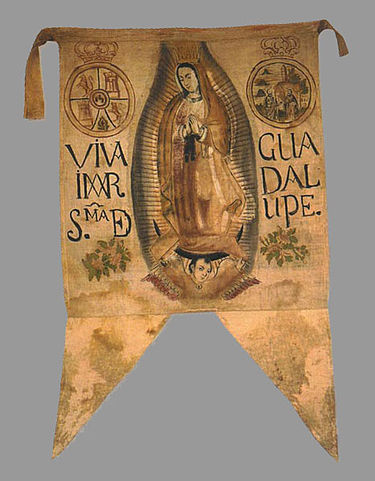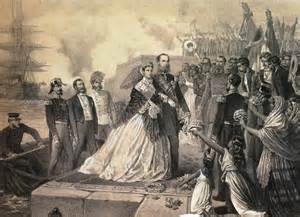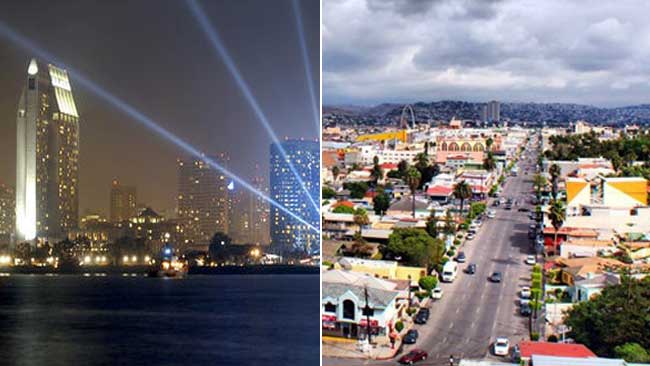Cortés conquered the Aztecs in 1521, and for the next 300 years,
New Spain, which included Latin America and parts of North and South America, was ruled by Catholic Spain.

In 1808,
Napoleon, who was a secular leader, invaded Catholic Spain and put his brother
Joseph Bonaparte on the Spanish throne.
Many in Catholic New Spain questioned their allegiance to this secular French king on the Spanish throne.
 Simon Bolivar
Simon Bolivar led a revolution against Spain, which led to the independence of
Venezuela, Colombia (which included
Panama),
Ecuador, Peru and
Bolivia, northern Peru, western Guyana and
northwest Brazil 
In
Mexico, in the year 1810, a priest named
Miguel Hidalgo gave a speech, "The Cry of Dolores," in protest of Napoleon holding captive Spain's King Fernando VII.
 Hidalgo
Hidalgo put the image of the Virgin of Guadalupe on a banner and rallied 90,000 poor peasant farmers to revolt against the Spanish Viceroy.
 Hidalgo's troops
Hidalgo's troops inscribed slogans on their flags: "Long live religion! Long live our most Holy Mother of Guadalupe! Long live America and death to bad government!"

Hidalgo was captured and executed. He is considered
the Father of the Nation of Mexico as the movement he began eventually led to Mexico's independence.

From 1821 to 1857, fifty different governments ruled Mexico.
Revolts and revolutions in Mexico usually began with
class-warfare, where the poor were organized to overthrow the rich, but
ended up with the revolutionary leaders themselves grabbing power-and becoming dictators.  Agustín de Iturbide
Agustín de Iturbide first fought for Spain against Hidalgo, but then switched to fight against Spain.
Iturbide made himself Emperor of Mexico, placing the crown on his own head in 1822.

Antonio López de Santa Anna, Vicente Guerrero and others conspired against him and he fled to Britain. Upon his return
Iturbide was executed.

Mexico was then ruled by a Supreme Executive Power, followed in 1824 by its first President,
Guadalupe Victoria, who was the
only president to complete his full term in more than 30 years of an independent Mexico.
 Manuel Gómez Pedraza
Manuel Gómez Pedraza won the second election, but Vicente Guerrero and Antonio López de Santa Anna staged a coup d'état, bombarding the palace.
 Vicente Guerrero
Vicente Guerrero became President in 1829, but was deposed and executed by his Vice-President Bustamante.
 Vice-President Bustamante
Vice-President Bustamante was deposed twice and exiled to Europe.
Between 1833 and 1855, the Mexican presidency changed hands at least 36 times, with
Antonio López de Santa Anna ruling 11 of those.
 Antonio López de Santa Anna
Antonio López de Santa Anna, styling himself after Napoleon, laid aside Mexico's Constitution in 1835, dissolved the Congress, and declared himself dictator.
 Santa Anna
Santa Anna had previously told the U.S. Minister to Mexico, Joel R. Poinsett, 1824:
"I threw up my cap for liberty with great ardor...but very soon found the folly of it. A hundred years to come my people will not be fit for liberty. They do not know what it is, unenlightened as they are...
A despotism is the proper government for them." 
After
Mexico finally won its
independence from Spain, September 27 1821,
others areas of Latin America declared themselves to be independent from both Spain and Mexico, becoming the nations of:
Guatemala, El Salvador, Costa Rica, Honduras, and
Nicaragua.  The dictator Santa Anna wanted to crush similar sentiments in Texas
The dictator Santa Anna wanted to crush similar sentiments in Texas.
Major events included:
Battle of Velasco, Jun. 26, 1832;
Battle of Gonzales, Oct. 2, 1835;
Battle of Goliad, Oct. 9, 1835;
Battle of Concepcion, Oct. 28, 1835;
Siege of Béxar ends, Dec. 11, 1835;
 Battle of the Alamo
Battle of the Alamo, Feb. 23-Mar. 6, 1836;
Texas Declaration of Independence, Mar. 2, 1836;
Goliad Massacre, Mar. 27, 1836;
Battle of San Jacinto, Apr. 21, 1836
. 
In 1845, the
Texas became the 28th U.S. State. The Mexican-American War began in April 25, 1846 and
ended FEBRUARY 2, 1848 with the
Treaty of Guadalupe (more below).

Santa Anna consolidated power to ensure his continued rule, but this led to resistance led by
Benito Juarez.In 1853,
Benito Juarez fled in exile to New Orleans and worked in a cigar factory.

In 1854, Benito Juarez plotted the
Revolution of Ayutla to oust Santa Anna from being dictator, forcing him to resign in 1855.
This resulted in a power vacuum, and the Church was caught in the middle.

Beginning in 1521, the Church in Mexico acted as a conscience influencing the elite to be considerate of the poor.
The Church, though, did not actively attempt to change the political structure and, as a result, was blamed by political revolutionaries for somehow maintaining the status quo of inequality.

In 1856, a
War of Reform broke out against the Church, ending with significant limitations placed upon it.

After political maneuvering,
Benito Juarez became President in 1858. As a Free Mason, Benito Juarez founded the Rito Nacional Mexicano lodge.
Benito Juarez stopped Mexico's repayment of loans borrowed from Spain, Britain and France, thus instigating European intervention.

In 1861, a delegation of Mexican leaders traveled to Europe and asked
Maximillian I, the younger brother of the Austro-Hungarian Emperor Franz Joseph I, to come to Mexico to restore order.
Meanwhile, in order to get repayment of debts, the
French forces of Napoleon III invaded Mexico, suffering a minor unexpected setback at the Battle of Puebla on
May 5 - Cinco de Mayo - 1862.

The French recovered and took control of Mexico.
Maximillian I agreed to rule Mexico, arriving with the Pope's blessing in 1864, being
greeted by an enthusiastic reception.
 Maximillian
Maximillian proceeded to enact many civil reforms to help the poor.
The United States Government, though, did not want any European powers intervening in the western hemisphere. This was called the Monroe Doctrine.
After America's Civil War ended,
the United States pressured Napoleon III to abandon support of Maximillian, which he did by withdrawing all French troops from Mexico.

The U.S. then began to secretly supply guns, in a clandestine, "Fast and Furious" style operation to arm Mexican gangs to cause domestic violence and insurrection.
Maximilian was captured, and despite pleas from European leaders,
Benito Juárez had him shot on June 19, 1867. 
Following the example of previous Mexican leaders,
Benito Juarez continued the practice of consolidating power to ensure his re-election.
This let to a revolt led by
Porfirio Diaz in 1871.
Juarez put down the revolt, but died of a heart attack and was succeeded by Lerdo de Tejada.

Lerdo de Tejada was overthrown by
Porfirio Diaz.
Porfirio Diaz was President for most of 1876 to 1911.
Following the example of previous Mexican leaders,
Porfirio Diaz continued the practice of consolidating power to ensure his re-elections.

This let to a revolt led by
Francisco Madero in 1911.
In the next decade of fighting, millions died as the secular Mexican government attempted to crush the church and silence political dissent.

Francisco Madero was murdered in a coup d'etat in 1913 by
Victoriano Huerta, which started a civil war.
Pancho Villa, Emiliano Zapata and
Álvaro Obregón forced
Victoriano Huerta to resign.

In 1914, Hollywood sent a crew to film
Pancho Villa as he fought from Durango to Mexico City.
Venustiano Carranza gained power with the backing of U.S. President Woodrow Wilson, who wanted Mexican oil for fighting Germany during World War I.

Woodrow Wilson and General Pershing supplied guns, in a clandestine "Fast and Furious" style manner to Carranza along the Mexican border.

Venustiano Carranza was assassinated in 1920, and was succeeded by Adolfo de la Huerta, who was then succeeded by the revolutionary Álvaro Obregón.

Obregón reportedly ordered the death of every rebel officer, including Pancho Villa.
Adolfo de la Huerta started a revolt against
Álvaro Obregón, but it was crushed.

In 1924, Obregón was succeeded by the aggressively anti-christian freemason,
Plutarco Elías Calles, who violently closed and confiscated churches, schools, convents, hospitals, seminaries, missions and monasteries.
 Calles'
Calles' radical atheist
"Calles Laws" made it illegal for clerical garb to be worn outside a church, imposed a 5-year prison sentence on pastors who criticized the government, and limited the number of clergy per state.

As portrayed in the movie,
For Greater Glory: Viva Crista Rey (2012), priests, ministers, and faithful laity were harassed, arrested and even murdered. Catholic women and girls were assaulted and raped.
This resulted in the
Cristero War, 1926-29, where over 90,000 were killed.
 Obregón
Obregón was again elected in 1928, but was soon assassinated.
Calles again assumed power, being nicknamed "Grand Turk" and "Jefe Máximo" (political chieftain).

Promoting revolutionary socialism,
Calles had Mexico host the Soviet Union's first embassy in any country.
Calles started Mexico's PNR party, the predecessor to the PRI party.
 President Portes Gil
President Portes Gil agreed not to enforce the "Calles Laws" but left them on the books.
In 1936,
President Lázaro Cárdenas deported Calles and repealed the "Calles Laws," thereby restoring some semblance of freedom of religion.
 Get the book THREE SECULAR REASONS Why America Should Be Under God
Get the book THREE SECULAR REASONS Why America Should Be Under GodBut back to 1848...
When the Mexican-American War ended on FEBRUARY 2, 1848, the
Treaty of Guadalupe-Hidalgo was signed at the altar of the Basilica of Our Lady of Guadalupe in Villa Hidalgo, in present day Mexico City.
 For $15 million dollars,
For $15 million dollars, coincidentally the same amount paid to France for the Louisiana Purchase, the United States
purchased from Mexico 525,000 square miles - the third largest land purchase in history. 
The largest land purchase was the
Louisiana Purchase of 828,000 square miles from France, and the second largest land purchase was the
586,412 square miles of Alaska from Russia after it lost the Crimean War to Britain.

The land acquired by the
Treaty of Guadalupe-Hidalgo became the U.S. States of:
California, Nevada, Utah, and parts of: Arizona, Texas, Kansas, Oklahoma, New Mexico, Colorado and Wyoming.

The Treaty of Guadalupe-Hidalgo began:
"
In the Name of Almighty God - the United States and the United Mexican States animated by a sincere desire to put an end to the calamities of the war....
have,
under the protection of Almighty God, the Author of Peace, arranged, agreed upon, and signed the following Treaty of Peace..."

In contrast to Mexico's many secular governments, the
Treaty of Guadalupe-Hidalgo guaranteed:
"If...
God forbid...war should unhappily break out...they...solemnly pledge...the following rules...
All churches, hospitals, schools, colleges, libraries, and other establishments for charitable and beneficent purposes, shall be respected,and all persons connected with the same protected in the discharge of their duties, and the pursuit of their vocations...Done at the city of Guadalupe Hidalgo, the 2ND DAY OF FEBRUARY,
in the year of the Lord one thousand eight hundred and forty-eight."

Since the Treaty of Guadalupe-Hidalgo, there developed
a stark contrast in the health, safety and economic status of the land
north of the border and the land
south of the border.

This is most obvious when comparing border cities
:
San Diego-Tiajuana;
El Paso-Juárez;,
Laredo-Nuevo Laredo;
Brownsville-Matamoros;
McAllen-Reynosa;
During the same period of time that Mexico has had several dozen different governments, the United States, other than the period of the Civil War, has had only one.
 Californian Ronald Reagan
Californian Ronald Reagan stated of America in 1961:
"In this country of ours, took place the greatest revolution that has ever taken place in world's history. The only true revolution.
Every other revolution simply exchanged one set of rulers for another." 
As both sides of the border have similar climate, geography, plants, and in many cases similar cultural-racial makeup, reasons for the disparity must lie deeper.

In 2012, U.S. Attorney General Eric Holder was held in contempt of Congress for his role in clandestinely supplying guns to Mexican drug gangs in "Fast and Furious" operation.
Increasing concern is developing over Muslim infiltration of these drug gangs.
Growing numbers of those entering America across the southern border are OTMs (Other Than Mexicans).

Many come from Islamic countries such as:
Afghanistan, Iran, Iraq, Egypt, Pakistan, Yemen, Qatar, Algeria, Somalia, Malaysia, Libya, Eritrea, Indonesia, and
Lebanon.Among the political differences north and south of the border are America's Judeo-Christian traditions of self-government.
The Declaration of Independence explained government was not to dominate, but to secure to each person their Creator given rights:
"All men are created equal, that they are endowed by their Creator with certain unalienable Rights...That to secure these rights, Governments are instituted among Men."
America's impartial system of rule of law was meant to guarantee there would never be rule by the whims and caprices of a dictator.
 President Ronald Reagan
President Ronald Reagan, who had been California's 33rd Governor, stated in 1983:
"
Of the many influences that have shaped the United States of America into a distinctive nation and people,
none may be said to be more fundamental and enduring than the Bible...
The Bible and its teaching helped form the basis for the founding fathers' abiding belief in
the inalienable rights of the individual, rights which they found implicit in the
Bible's teachings of the inherent worth and dignity of each individual."
 THREE SECULAR REASONS Why America Should Be Under God
THREE SECULAR REASONS Why America Should Be Under God